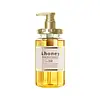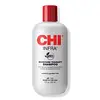What's inside
What's inside
 Key Ingredients
Key Ingredients

No key ingredients
 Benefits
Benefits

 Concerns
Concerns

 Ingredients Side-by-side
Ingredients Side-by-side

Water
Skin ConditioningLauramidopropyl Betaine
CleansingSodium C14-16 Olefin Sulfonate
CleansingSodium Lauroyl Taurate
CleansingGlycerin
HumectantCocamide DEA
EmulsifyingTea-Lauroyl Methylaminopropionate
CleansingTea-Cocoyl Glutamate
CleansingParfum
MaskingPolyquaternium-10
Sodium Benzoate
MaskingMyristyl Betaine
CleansingPhenoxyethanol
PreservativeCitric Acid
BufferingDisodium EDTA
Polyquaternium-47
Skin ConditioningMenthol
MaskingCaramel
Cosmetic ColorantHoney
HumectantArginine
MaskingPanthenol
Skin ConditioningArgania Spinosa Kernel Oil
EmollientShea Butter Glycereth-8 Esters
CleansingButylene Glycol
HumectantGluconobacter/Honey Ferment Filtrate
Skin ConditioningPPG-7
Skin ConditioningAcacia Senegal Gum
MaskingHoney Extract
HumectantCoco-Glucoside
CleansingKeratin
Skin ConditioningHydrolyzed Honey Protein
Skin ConditioningRoyal Jelly Extract
Skin ConditioningPaeonia Officinalis Flower Extract
TonicPropolis Extract
Skin ConditioningHydrolyzed Silk
HumectantHydroxypropyltrimonium Hyaluronate
Methylchloroisothiazolinone
PreservativeMethylisothiazolinone
PreservativePotassium Sorbate
PreservativeMagnesium Nitrate
Magnesium Chloride
Water, Lauramidopropyl Betaine, Sodium C14-16 Olefin Sulfonate, Sodium Lauroyl Taurate, Glycerin, Cocamide DEA, Tea-Lauroyl Methylaminopropionate, Tea-Cocoyl Glutamate, Parfum, Polyquaternium-10, Sodium Benzoate, Myristyl Betaine, Phenoxyethanol, Citric Acid, Disodium EDTA, Polyquaternium-47, Menthol, Caramel, Honey, Arginine, Panthenol, Argania Spinosa Kernel Oil, Shea Butter Glycereth-8 Esters, Butylene Glycol, Gluconobacter/Honey Ferment Filtrate, PPG-7, Acacia Senegal Gum, Honey Extract, Coco-Glucoside, Keratin, Hydrolyzed Honey Protein, Royal Jelly Extract, Paeonia Officinalis Flower Extract, Propolis Extract, Hydrolyzed Silk, Hydroxypropyltrimonium Hyaluronate, Methylchloroisothiazolinone, Methylisothiazolinone, Potassium Sorbate, Magnesium Nitrate, Magnesium Chloride
Water
Skin ConditioningSodium C14-16 Olefin Sulfonate
CleansingCocamidopropyl Betaine
CleansingGlycol Distearate
EmollientDisodium Laureth Sulfosuccinate
CleansingHydrolyzed Silk
HumectantPanthenol
Skin ConditioningCocodimonium Hydroxypropyl Hydrolyzed Keratin
Skin ConditioningAcrylates Copolymer
Caprylyl Glycol
EmollientPhenoxyethanol
PreservativePEG-150 Pentaerythrityl Tetrastearate
EmulsifyingPolyquaternium-10
Disodium EDTA
PEG-6 Caprylic/Capric Glycerides
EmulsifyingPotassium Sorbate
PreservativeHexylene Glycol
EmulsifyingCitric Acid
BufferingParfum
MaskingBenzyl Benzoate
AntimicrobialHexyl Cinnamal
PerfumingWater, Sodium C14-16 Olefin Sulfonate, Cocamidopropyl Betaine, Glycol Distearate, Disodium Laureth Sulfosuccinate, Hydrolyzed Silk, Panthenol, Cocodimonium Hydroxypropyl Hydrolyzed Keratin, Acrylates Copolymer, Caprylyl Glycol, Phenoxyethanol, PEG-150 Pentaerythrityl Tetrastearate, Polyquaternium-10, Disodium EDTA, PEG-6 Caprylic/Capric Glycerides, Potassium Sorbate, Hexylene Glycol, Citric Acid, Parfum, Benzyl Benzoate, Hexyl Cinnamal
 Reviews
Reviews

Ingredients Explained
These ingredients are found in both products.
Ingredients higher up in an ingredient list are typically present in a larger amount.
Citric Acid is an alpha hydroxy acid (AHA) naturally found in citrus fruits like oranges, lemons, and limes.
Like other AHAs, citric acid can exfoliate skin by breaking down the bonds that hold dead skin cells together. This helps reveal smoother and brighter skin underneath.
However, this exfoliating effect only happens at high concentrations (20%) which can be hard to find in cosmetic products.
Due to this, citric acid is usually included in small amounts as a pH adjuster. This helps keep products slightly more acidic and compatible with skin's natural pH.
In skincare formulas, citric acid can:
While it can provide some skin benefits, research shows lactic acid and glycolic acid are generally more effective and less irritating exfoliants.
Most citric acid used in skincare today is made by fermenting sugars (usually from molasses). This synthetic version is identical to the natural citrus form but easier to stabilize and use in formulations.
Read more about some other popular AHA's here:
Learn more about Citric AcidDisodium EDTA plays a role in making products more stable by aiding other preservatives.
It is a chelating agent, meaning it neutralizes metal ions that may be found in a product.
Disodium EDTA is a salt of edetic acid and is found to be safe in cosmetic ingredients.
Learn more about Disodium EDTAYou can find hydrolyzed silk in both haircare and skincare products. According to a manufacturer, it can help improve skin and hair hydration.
This ingredient is created by adding acid or enzymes to 'hydrolyze' silk protein.
Due to the origins of this ingredient, it is not vegan. Silk is an animal product from silkworms.
Depending on the source, this ingredient can be considered cruelty-free. It is created from left-over cocoons of silkworms. We recommend reaching out to the brand if you have questions about where their hydrolyzed silk comes from.
Learn more about Hydrolyzed SilkPanthenol is a common ingredient that helps hydrate and soothe the skin. It is found naturally in our skin and hair.
There are two forms of panthenol: D and L.
D-panthenol is also known as dexpanthenol. Most cosmetics use dexpanthenol or a mixture of D and L-panthenol.
Panthenol is famous due to its ability to go deeper into the skin's layers. Using this ingredient has numerous pros (and no cons):
Like hyaluronic acid, panthenol is a humectant. Humectants are able to bind and hold large amounts of water to keep skin hydrated.
This ingredient works well for wound healing. It works by increasing tissue in the wound and helps close open wounds.
Once oxidized, panthenol converts to pantothenic acid. Panthothenic acid is found in all living cells.
This ingredient is also referred to as pro-vitamin B5.
Learn more about PanthenolParfum is a catch-all term for an ingredient or more that is used to give a scent to products.
Also called "fragrance", this ingredient can be a blend of hundreds of chemicals or plant oils. This means every product with "fragrance" or "parfum" in the ingredients list is a different mixture.
For instance, Habanolide is a proprietary trade name for a specific aroma chemical. When used as a fragrance ingredient in cosmetics, most aroma chemicals fall under the broad labeling category of “FRAGRANCE” or “PARFUM” according to EU and US regulations.
The term 'parfum' or 'fragrance' is not regulated in many countries. In many cases, it is up to the brand to define this term.
For instance, many brands choose to label themselves as "fragrance-free" because they are not using synthetic fragrances. However, their products may still contain ingredients such as essential oils that are considered a fragrance by INCI standards.
One example is Calendula flower extract. Calendula is an essential oil that still imparts a scent or 'fragrance'.
Depending on the blend, the ingredients in the mixture can cause allergies and sensitivities on the skin. Some ingredients that are known EU allergens include linalool and citronellol.
Parfum can also be used to mask or cover an unpleasant scent.
The bottom line is: not all fragrances/parfum/ingredients are created equally. If you are worried about fragrances, we recommend taking a closer look at an ingredient. And of course, we always recommend speaking with a professional.
Learn more about ParfumPhenoxyethanol is a preservative that has germicide, antimicrobial, and aromatic properties. Studies show that phenoxyethanol can prevent microbial growth. By itself, it has a scent that is similar to that of a rose.
It's often used in formulations along with Caprylyl Glycol to preserve the shelf life of products.
Polyquaternium-10 is an ammonium salt of hydroxyethylcellulose. It is a white and granular powder used as a film-former and anti-static agent.
This ingredient is commonly found in hair conditioning products. According to a manufacturer, its positive charge makes it great for absorbing hair proteins. The manufacturer also states this ingredient helps with curl retention.
For haircare friends: this ingredient is not a silicone.
Learn more about Polyquaternium-10Potassium Sorbate is a preservative used to prevent yeast and mold in products. It is commonly found in both cosmetic and food products.
This ingredient comes from potassium salt derived from sorbic acid. Sorbic acid is a natural antibiotic and effective against fungus.
Both potassium sorbate and sorbic acid can be found in baked goods, cheeses, dried meats, dried fruit, ice cream, pickles, wine, yogurt, and more.
You'll often find this ingredient used with other preservatives.
Learn more about Potassium SorbateSodium C14-16 Olefin Sulfonate is a cleansing agent made from a mixture of long chain sulfonate salts. It can also help produce foam.
This ingredient may be drying. We recommend speaking with a professional if you have concerns.
Water. It's the most common cosmetic ingredient of all. You'll usually see it at the top of ingredient lists, meaning that it makes up the largest part of the product.
So why is it so popular? Water most often acts as a solvent - this means that it helps dissolve other ingredients into the formulation.
You'll also recognize water as that liquid we all need to stay alive. If you see this, drink a glass of water. Stay hydrated!
Learn more about Water